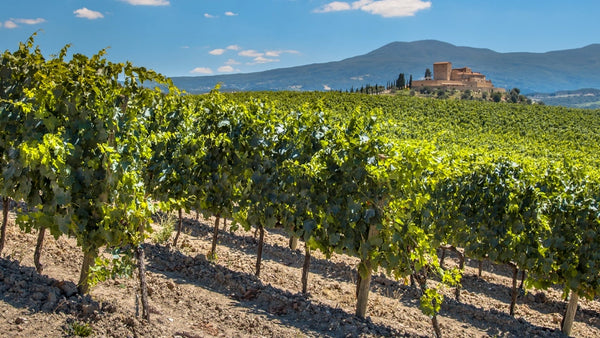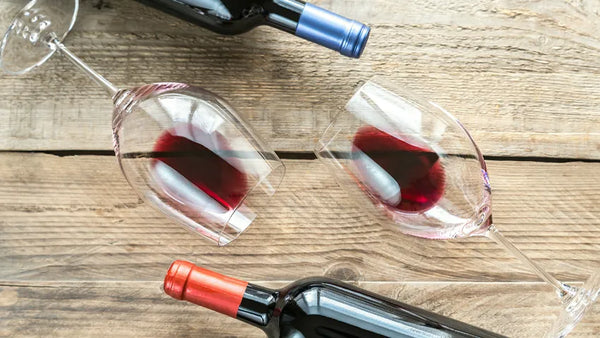Guide to Sangiovese: Learn All About Italy’s Most Famous Grape (And the Wines to Know)

Say hello to Sangiovese - Italy’s most popular wine grape. We aren’t kidding - it is the most commonly planted varietal in the country for a reason. With its lengthy history and incredible wine potential, there are many reasons why Sangiovese is so loved.
Continue reading to discover why Sangiovese is one of Italy’s noble grape varietals and explore all the fabulous wines it creates.
The History of Sangiovese
The history of Sangiovese is deeply rooted in Italy, particularly in the central regions of Tuscany and Emilia-Romagna. While its exact origins are still debated among wine experts, Sangiovese is no doubt an ancient grape whose home is the Italian peninsula (although Tuscans will tell you it is Tuscany!)
Historical records indicate that Sangiovese has been grown in Italy since at least the 16th century. Over time, it became the major grape variety in Tuscany, particularly in the Chianti region just south of Florence. The grape's adaptability to the Tuscan terroir, with its warm Mediterranean climate and versatile, often limestone-rich soils, contributed to its widespread cultivation.
In the late 19th century, a renowned Tuscan winemaker named Baron Bettino Ricasoli played a significant role in shaping the character and reputation of Sangiovese. Ricasoli experimented with different grape varieties and winemaking techniques, eventually formulating the modern recipe for Chianti, which featured Sangiovese as the primary grape. His work influenced the specific regulations for the Chianti production we see today.
Moving to the 20th century, Sangiovese faced some challenges due to its reputation for producing rustic and low-quality wines. However, with advancements in viticulture and winemaking techniques, along with a renewed focus on quality, Sangiovese began to regain its status as one of Italy's premier grape varieties. Today, it is celebrated for producing a wide range of wines, from approachable and fruity to complex and age-worthy.
Where Does Sangiovese Get Its Name From?
The name "Sangiovese" is thought to derive from the Latin term "Sanguis Jovis," meaning "the blood of Jove" (Jove being an ancient Roman god). This name indicates the high quality and noble nature of the grape variety.
Where is Sangiovese Grown?

Sangiovese is primarily grown in Italy, particularly in the central regions of Tuscany, Emilia-Romagna, and Umbria. Tuscany, in particular, is known as the heartland of Sangiovese, where the grape thrives in Tuscany's diverse microclimates and soils.
In addition to Tuscany, Sangiovese is also grown in the neighboring region of Emilia-Romagna, where it is used in the production of wines such as Sangiovese di Romagna. Furthermore, Sangiovese is found in smaller quantities in other Italian regions, including Umbria, Marche, and Lazio.
Beyond Italy, Sangiovese has gained some international presence, with plantings in other wine regions worldwide. For example, there are Sangiovese vineyards in California, particularly in the regions of Napa Valley and Sonoma County, where it is often used in Super Tuscan-style blends. Australia, Argentina, and Chile also grow Sangiovese, exploring its potential in different climates and soils. However, Sangiovese's reputation remains the strongest in its Italian homeland.
Sangiovese, Vinified
Sangiovese is a grape variety that produces wines that vary in style and quality. The character of Sangiovese wines depends on several factors, including where its cultivated, winemaking techniques, and the aging process.
Getting into the styles of Sangiovese, we see quite an impressive range. It can produce light-bodied and vibrant wines with bright acidity and red fruit flavors. These wines are often enjoyed in their youth and can exhibit notes of cherries, raspberries, and cranberries. This easygoingness goes for its rosé or rosato wines as well. Sangiovese rosato is typically dry and super refreshing. These rosés often exhibit vibrant acidity, red berry flavors, and floral aromas, with a pale pink to deeper, more intense hue.
On the other hand, Sangiovese wines can produce ultra-elegant wines with great aging potential. This is arguably the most classic expression of Sangiovese, seen in the famous Tuscan wines like Chianti, Brunello di Montalcino, and Vino Nobile di Montepulciano. These wines are typically medium-bodied and showcase harmonious red fruit flavors, earthiness, and herbal notes. They usually have moderate tannins, good acidity, and aging potential. As these wines age, they can develop enchanting notes of dried herbs, tobacco, and leather.
Finally, Sangiovese can yield wines with greater concentration, intensity, and power. It all depends on the wine region and specific winemaking techniques! A primary example is Super Tuscans which typically incorporate international grape varieties like Cabernet Sauvignon or Merlot to enhance the structure and complexity. Surprisingly, Sangiovese plays well with these other dominant grape varieties. The result is wines with darker fruit flavors, firm tannins, and a resounding ability to age.
The Sangiovese-Based Wines to Know
The following wines all feature Sangiovese as the star. Yet, their terroir, winemaking styles, and history diversify their characters.

Chianti
Chianti is a DOCG red wine produced in Tuscany's Chianti region, located just south of Florence. It must contain a minimum of 80% Sangiovese grapes. It's important to note that Chianti spans a wide range of quality levels, from simple, everyday-drinking Chianti to more premium and age-worthy wines.
Chianti Classico, produced in the historic heartland of the region, is regarded as the higher quality level within the Chianti hierarchy. Chianti Classico's stricter regulations and emphasis on Sangiovese as the main grape define the finessed character of these wines.
Other specific Chianti regions exist, such as Ruffina and Colli Senesi. Nonetheless, the style of Chianti wines can vary depending on several factors, including the subregion within Chianti, the winemaking techniques employed, and the quality level of the wine.
Brunello di Montalcino
This is a prestigious and age-worthy red wine produced in the municipality of Montalcino in Tuscany. It is made entirely from Sangiovese and has some pretty strict aging requirements. Brunello di Montalcino wines must be aged 5 years before release, according to the DOCG regulations. This contributes to the wine's elegance, full body, and prestige.
Rosso di Montalcino
Often referred to as the "younger sibling" of Brunello di Montalcino, Rosso di Montalcino is also made from Sangiovese grapes. But, it is aged for a much shorter period. It is typically lighter and more approachable than Brunello.
Vino Nobile di Montepulciano
Another esteemed red wine from Tuscany, Vino Nobile di Montepulciano is the historic red wine of the Montepulciano region. It must contain at least 70% Sangiovese grapes (with the remaining 30% a blend of local grapes). Vino Nobile is one of Tuscany's hidden gems - it's lesser known than its Chianti brethren but produces very beautiful, age-worthy wines.
Morellino di Scansano
Morellino di Scansano is a wine native to Tuscany's Maremma region. As a warmer wine region, Sangiovese shows off a slightly juicier side. Morellino di Scansano is made primarily from Sangiovese and is known for its smooth, ripe fruit flavors.
Sangiovese’s Role in Super Tuscans Wine
Super Tuscans often feature blends of Sangiovese with international grape varieties, particularly Cabernet Sauvignon and Merlot. They represent a fusion of traditional Italian winemaking with modern innovation and have played a significant role in elevating the reputation of Tuscan wines on the global stage. They emerged in the 1970s as a response to the restrictive regulations and traditional winemaking practices. Super Tuscans deviated from the legal requirements established for Tuscan wines, particularly those of the Chianti region.
While these wines do not highlight Sangiovese, Super Tuscan shows how this all-star Italian grape plays nice in blends with international varietals. It lends its naturally bright and acidic color to the wines. Today, Super Tuscans continue to be sought-after wines, admired for their quality, complexity, and ability to express the unique terroir of Tuscany.
Sangiovese Wines To Try
Chianti: 2020 Campo Pietra Chianti Riserva
Chianti Classico: 2018 Casanuova di Nittardi 'Vigna Doghessa' Chianti Classico
Chianti Classico Riserva: 2015 Mazzei Castello di Fonterutoli Gran Selezione Chianti Classico
Brunello di Montalcino: 2015 La Fiorita Brunello di Montalcino
Rosso di Montalcino: 2019 Colle Nero Tra Di Noi Rosso Di Montalcino DOCG
Vino Nobile di Montepulciano: 2019 Talosa Alboreto Vino Nobile Di Montepulciano DOCG
Morellino di Scansano: 2019 Fattoria Le Pupille 'Poggio Valente' Morellino di Scansano Riserva
Super Tuscan: 2020 Tenuta San Guido Guidalberto Toscana
Big Hammer Wines
The wine experts at Big Hammer Wines taste thousands of wines every year from around the globe, looking for quality and value. This special offer reflects the passion we have for our clients.
Discover the world through its wines, Click Here! Visit Bighammerwines.com and become a wine expert!
Leave a comment (all fields required)
Comments will be approved before showing up.


